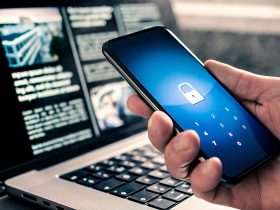By simply holding your finger on your smartphone display, you can unlock your device — all thanks to biometric data. You can also often use biometric data to access systems in your company, bank accounts, or other services. Although convenient and time saving, there’s a risk that your biometric data could get compromised. Read on to learn more about the upsides and downsides of using biometric data and also discover how Avira Free Security can help make your online activities safer.
What is biometric data?
Biometrics refers to unique physical or biological characteristics. Using statistical and mathematical measurements, they help to uniquely identify someone. Biometric data is used in a wide range of sectors — and is becoming increasingly popular, especially in the area of digital data protection. That’s because it makes it easier for us to log in to our online accounts and devices, plus it makes it harder for cybercriminals to access our personal information.
Biometric security in the digital era
Biometric security refers to the use of biometric data to identify a person. In a business, for example, this can be used as a means of access control and authentication. For this to work, hardware components such as a device’s camera or fingerprint reader capture the data and compare it with previously stored information. If the data matches, the person’s identity is considered authenticated and the user is granted access.
Types of biometric security system
Depending on the hardware and software, there are differences in how users can verify their login with their biometric data instead of an email address and password, for example. There are basically three main types of biometric security. Let’s explore them.
Biological biometrics: Your DNA profile
DNA is the most accurate biometric feature, where a person’s identity can be determined based on their blood, saliva, or hair. However, it takes too long to analyze to use this biometric data for everyday security checks. DNA is usually used as evidence in criminal proceedings.
Physical biometrics: A widely used authentication method
Physical biometrics are most commonly used to authenticate a person’s access. These include the structure of the retina, the fingers or hands, and the face. In some cases the voice is also used as an identification factor. Here are some common examples of physical characteristics used for authentication:
- Retina: Retina scanning looks at the arrangement of blood vessels in the posterior retina. The pattern is unique for each person. This biometric method for data recognition is relatively slow and is usually only used by companies or government agencies. It’s still uncommon in the private sector
- Iris: An iris scan captures the colored part of the eyes around the pupil and is faster but less accurate than retina scanning. Nevertheless, the scan is considered reliable. While this type of biometric security is already common in some companies, it’s only gradually being implemented in smartphones
- Fingerprint: The human fingerprint is one of the most common biometric characteristics, allowing people to be identified thanks to the unique pattern of the papillary ridges. Among its applications, users can use a fingerprint scanner in their smartphone to unlock the device. Most passports also contain fingerprint biometrics, enabling the holder to identify themselves
- Facial structure: Facial recognition determines the position, distance, and location of various features of a person such as their eyes, nose, and mouth. Many mobile devices can be unlocked using facial recognition. You can also use it to access certain apps
- Voice: Your voice is also a biometric identifier in physical terms. To recognize you, technology measures its frequency, pitch, and accent. These are converted into electrical signals so the software can identify the person. But because it’s considered rather inaccurate, it is rarely used as a biometric security factor. Voice recognition is primarily used by digital voice assistants to learn more about the user’s pronunciation so the assistant can respond better to user prompts.
Behavioral biometrics: Your digital browser fingerprint
Your behavior can also be used to identify you. Such things include your handwriting, the way you walk, or your surfing habits. In the case of the latter, artificial intelligence can create a unique browser fingerprint based on how you interact with your device. Behavioral biometrics can be used partly for marketing purposes, but so far it’s rarely been used to authenticate people. Thankfully, businesses and regular users can reduce the risk of third parties tracking what they get up to online with a VPN (virtual private network).
By the way: You can encrypt your data traffic and route it through a secure tunnel with Avira Phantom VPN. This means third parties can’t access it and cannot track or manipulate your online activities. This helps make your browsing experience safer and more anonymous.
How is biometric data stored?
Three components are required to store biometric data:
- A sensor: The sensor detects your physical characteristics. This could be a fingerprint sensor or a camera.
- A computer: Whether in the form of a smartphone or a computer — the computer processes the data collected by the sensor and stores it in a digital, encrypted format.
- Software: Special software compares the data collected by the sensor with the previously stored biometric characteristics in its database.
If the recorded biometric data matches the previously stored characteristics, the user is granted access.
Biometric data: How secure is this authentication method?
Compared to traditional security methods, biometric data is much more secure. Because of its complexity and uniqueness, it’s harder to hack. However, that does not mean it cannot be compromised. The more often people use their biometric data across different apps, the more likely it is to become compromised through a data breach.
The widespread use of biometric systems also raises privacy concerns — if the data falls into the wrong hands, the risk of identity theft and fraud for users increases. In general, though, other authentication methods like usernames and passwords are much more prone to being abused by cybercriminals in the event of a data breach.
Advantages of biometric methods
Biometric data is unique and is becoming an increasingly popular method of authentication in many sectors. Another factor that contributes to this is that using biometric security is so convenient. A scan is much faster than entering a password or rifling through your pockets to find that illusive key. People always carry their biological characteristics with them. One area where biometric access control is used is in the workplace. Thanks to biometric scanners, if you turn up at work and find you’ve left your key card behind, a quick scan is all it takes and you’ll be permitted to enter the premises.
Risks of biometric authentication systems
In addition to the advantages of biometric data as a security factor, there are also risks. The main concerns include:
- Hacking: If biometric data is hacked, it cannot simply be changed unlike a password. This may pose an ever-present risk
- Theft: Criminals can get hold of biometric credentials more easily than you might think. If they’re targeting a specific person, criminals can lift the individual’s fingerprints from a glass. Using simple methods, they can then create a copy of the fingerprint and gain access. Voice authentication methods pose a similar risk just by recording the person’s voice. Similarly, hackers can trick facial-recognition systems using models created from images from social media accounts
- Privacy: Voice assistants record what users say to learn to understand them better. However, cybercriminals can break into IoT devices and steal and misuse the stored biometric data.
Because of these risks, it’s important to take protective measures so you can safely use authentication methods with biometric data — both in a professional and private context.
Protective measures for biometric data
In general, you can safely secure access to a company, devices, or apps using biometric data. In addition, this procedure is extremely convenient as it saves time. However, to ensure that companies and employees remain equally protected, it’s best to take a multi-layered security approach.
- Use two-factor authentication: It’s advisable to set up two-factor authentication (2FA) to make access to online accounts more secure. 2FA provides an extra layer of security in addition to biometric data to authenticate yourself. Examples include a one-time code (OTC) that’s sent to a previously saved cell phone number. Users must enter this to log in, making it more difficult for hackers to gain access to their online accounts — even if they’ve compromised the users’ biometric authentication data
- Use authentication apps: Authentication apps help to hide biometric data. Some use what are called tokens that convert the data into a random code after scanning. To decrypt it, the appropriate decryption code is required, which only previously specified users have access to. This reduces the risk that stored biometric data will be disclosed.
- Keep software up to date: Outdated software can be riddled with security holes. Therefore, always keep your software up to date. This makes it more difficult for hackers to gain access to devices and steal sensitive data.
Biometric security: Indispensable in the digital age
Compared to other authentication methods, biometric data offers increased security. So that you can protect devices like your smartphone effectively from hackers, it’s important to take additional security precautions — especially in the corporate sector. As such, it’s worthwhile using biometric security only as a complementary tool to other existing systems such as antivirus solutions.
Avira Free Security includes real-time antivirus protection thanks to cloud-based detection of the latest threats. This will keep your data safe from phishing and other online threats. Together with biometric data, you can make your surfing experience and your internet-enabled devices more secure.














